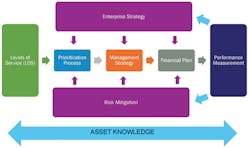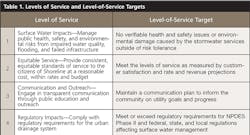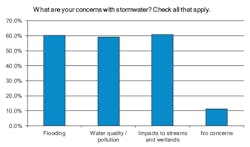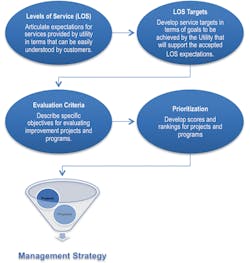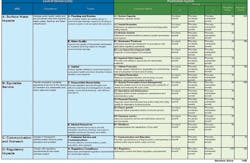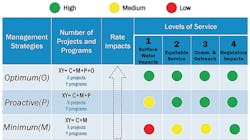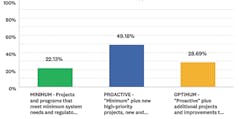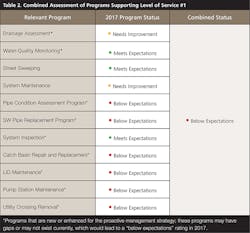Asset management (AM) is a popular management strategy for maintaining the level of service for water and wastewater systems. These systems have clearly defined services and objectives and have been tested and regulated for much longer than stormwater systems. Compared to wastewater, stormwater less frequently receives direct treatment to remove pollutants, making it challenging to meet numeric effluent limitations. The main obligation of most stormwater systems was once to collect rainfall runoff for reduction of flooding. Stormwater is typically not treated. However, with the increasing water-quality regulations, more obligations are being introduced for stormwater systems, including total maximum daily loads (TMDLs).
Asset management for stormwater systems is becoming increasingly essential for achieving water-quality objectives while continuing to provide flood protection. Asset management is a structured approach to optimizing the life cycle cost of asset ownership and focuses on providing reliable and dependable service to customers. The goal of an AM program is to meet customer needs and expected levels of service (LOS) through sound fiscal planning and improved infrastructure management.
With aging infrastructure, increasing water-quality regulations, and the multifaceted needs for surface water and stormwater management, there is an increasing need for a transparent, feasible, and proactive long-term management strategy for stormwater infrastructures. The city of Shoreline, WA, is using AM principles to manage the stormwater program, not only to exceed permit requirements but also to meet residents expectations for rates, flood protection, and environmental substantiality.
The city’s AM program provides a long-term management strategy for the city surface water utility to manage the stormwater assets at the lowest life cycle cost while meeting the expected LOS. It provides a transparent way to inform difficult investment decisions, educate residents and the city council about the system needs, and ensure proper allocation and acquisition of funding for construction, operations, and long-term maintenance of the stormwater system.
Background
The city of Shoreline is located in King County, WA, and is approximately 12 square miles. The city is bordered on the south by Seattle and on the west by Puget Sound, the second-largest estuary in the US after Chesapeake Bay.
The city has a surface water utility that serves more than 55,000 residents and 780 businesses. The utility operates and maintains a municipal separate storm sewer system (MS4) within seven drainage basins. In 2016, the city completed its first installment of drainage basin plans that began in 2009.
Through the basin plans, the city learned a great deal about the stormwater system and about residents’ expectations and identified a growing list of activities and projects to address the needs of the system. To better manage and prioritize the list of activities identified, the city established an asset management framework as a strategy for long-term management of the system instead of merely reacting to the identified needs.
The asset management framework is the basis for the city’s AM program and was developed in the 2018 Comprehensive Surface Water Master Plan. This plan includes a compilation of all the data and assessment from the completed basin plans and a long-term management strategy (enterprise strategy and risk mitigation) for meeting the established LOS. The master plan will guide utility activities for the next five to 10 years and includes policies, programs, a schedule for capital improvement projects, and a financial plan for long-term asset management.
Stormwater System
The city’s MS4 includes approximately 140 miles of stormwater pipe, 7,461 catch basins, more than 260 green stormwater infrastructures (bioretention, rain gardens, permeable pavements, etc.), and eight pump stations. The MS4 has approximately 148 outfalls that discharge directly into creeks, lakes, ponds, and Puget Sound.
NPDES Permit
The utility also holds a National Pollutant Discharge and Elimination System (NPDES) Phase II municipal stormwater permit for Western Washington. This Phase II permit, administered by the Washington State Department of Ecology (DOE), allows the discharge of stormwater to waters of the state if the utility takes certain actions to minimize stormwater pollution in the discharge. These actions are specified in the Phase II permit, including specific requirements for operations and maintenance and documenting a stormwater management program.
Although the current Phase II permit does not explicitly require treatment for outfall and discharges, it does require compliance with any TMDLs established for water bodies that receive municipal stormwater runoff. However, none of the water bodies within the city has TMDL requirements.
Asset Management Framework
The city’s AM program is based on an asset management framework with various elements including LOS, asset knowledge, risk mitigation, and enterprise strategy. Figure 1 outlines the various elements of the AM framework. The AM program helps the city maintain its mission of protecting public health and the environment by improving the knowledge and management of assets. Two basic concepts of asset management are to maximize the useful life of assets and to reduce life cycle costs. Measurement of asset performance and processes are key to sustaining the AM program.
One of the goals of the AM program is to ensure the delivery of prioritized activities (projects and programs) identified in the basin plans while managing the life cycle cost of assets and improving asset reliability. The AM program requires an ongoing collaboration among the engineering, operations, maintenance, finance, and information technology groups.
Asset Knowledge
Asset knowledge is critical in telling a comprehensive story for stormwater management programs and achieving the AM program goals. The knowledge of the city’s assets is captured in Cityworks, a computerized maintenance management system (CMMS) and geographic information system (GIS). The use of CMMS and GIS to capture this information allows the city to understand the assets from any level and performance across multiple queries.
The asset knowledge is also enhanced through strategic drainage basin planning. Drainage basin planning is an approach to stormwater management that provides detailed drainage assessment and identifies problems, system needs, and management activities to address the needs. Drainage basin plans can also provide better information on needs and activities to address the protection and restoration of the beneficial uses of our water bodies.
As a Phase II permittee, the city is not required to perform drainage basin planning. The current NPDES permit includes drainage basin planning requirement for Phase I permittees and requires Phase II permittees within a Phase I selected drainage basin to participate or conduct their drainage basin plans independently. The city is not within any of the drainage basins selected for Phase I planning.
However, in 2009 the city began studying the stormwater and surface water systems on a drainage basin level. This study was aimed at understanding the needs of the system in the seven drainage basins within the city boundaries. The basin plans included GIS mapping updates, condition assessment of pipes and catch basins, assessment of drainage and flooding issues, review of operations and maintenance records, and stream and water-quality assessment in each of the drainage basins. In 2016, the city completed the final basin plan and compiled all the data and assessments into a comprehensive plan, the Surface Water Master Plan. This master plan includes the enterprise strategy and risk mitigation elements of the AM program.
Service Levels
Levels of service are key in assessing the utility’s AM program. The LOS are the services provided by the utility to meet the residents’ expectations and permit requirements. This requires a clear understanding of customers’ needs, expectations, and preferences. The associated targets and performance measures will guide the city’s activities, such as maintenance frequency, inspection techniques, and capital improvement sizing.
With the help of consultants (Brown and Caldwell and FCS Group), the city worked with residents through open houses and surveys to define the LOS and LOS targets shown in Table 1. Having defined LOS and LOS targets helped frame the identified activities and long-term management needs in the context of the residents’ and the utility ratepayers’ expectations and has been foundational in establishing the AM program.
A public survey was conducted to solicit feedback on the LOS and gain a better understanding of customer expectations for stormwater services. Key findings from the web-based survey include the following:
- Respondents ranked “Manage public health, safety, and environmental risks from impaired water quality, flooding, and failed infrastructure” as the highest priority.
- Respondents ranked “Engage in transparent communication through public education and outreach” as the lowest priority.
- General concerns about the stormwater services were relatively evenly distributed among flooding, water quality/pollution, and impacts to streams and wetlands (Figure 2).
Each of the defined service levels will have key performance indicators (KPIs) or metrics to determine if each service level is being met. These metrics will be the basis for revising priorities for funding among competing demands and will ultimately be used to demonstrate how resources will be dedicated to achieving specific results for the long-term management of the stormwater system.
Risk Mitigation
Risk mitigation in implementing the AM program involves developing options and actions to enhance opportunities to meet the LOS targets while reducing threats to asset performance. Evaluating risk will ensure that failure modes can be identified, acceptable levels of risk can be evaluated, critical assets and business processes are identified, consequences or failures are known, and risks are avoided or reduced. Outcomes for the risk mitigation will involve assets with low consequences of failure and no periodic maintenance requirements simply being used until broken, while assets with high consequences of failure will be prioritized for repair and replacement.
Enterprise Strategy
The enterprise strategy in the master plan identifies the goals of the utility and the approach for reaching these goals. This strategy includes prioritizing projects and program activities for the utility and establishing a management strategy for implementing these activities within a corresponding financial strategy.
Prioritization Process. A systematic process was developed for prioritizing the improvement projects and current and recommended programs, including a spreadsheet tool that applies a consistent set of criteria and a procedure for scoring. Key steps of the prioritization are described below and summarized in Figure 3:
- Refine LOS Targets. As discussed earlier, the LOS and LOS targets are the basis for articulating customer expectations for the services provided by the utility. LOS targets were refined to reflect key goals relating to flooding and erosion, water quality, aquatic habitat, responsible stewardship of assets, customer service and communications, and regulatory compliance. These targets were then carried forward to support project and program prioritization, as well as monitoring and tracking of operational activities.
- Develop Evaluation Criteria and Scoring. LOS targets were further refined into specific evaluation criteria. For example, the target for “flooding and erosion” was divided into three separate criteria relating to drainage capacity, hazard reduction, and erosion control. Scores of 0, 1, or 2 are assigned to each criterion based on guidance provided in the spreadsheet tool. These scores are then multiplied by a weighting factor and added to the scores from the other criteria for a total project score.
- Develop Rankings. After scoring was completed, the projects and programs were ranked highest to lowest by their total scores and tabulated with other key information such as estimated cost, type, location, and the primary issue addressed. For the projects, the rankings table and supporting information were used to identify projects for the six-year capital improvement program (CIP), with the remainder moving to the 20-year horizon. Projects selected for the six-year CIP were then examined in closer detail with respect to implementation. Several projects were divided into phases where pre-design/feasibility studies were needed or engineering and planning must be done well in advance of construction.
Figure 4 shows the prioritization process matrix and the steps in developing this process from the LOS to scoring.
Management Strategy. The prioritized projects and programs were then examined within the context of different management strategies to examine the long-term financial impacts. Projects (capital expenses) and programs (operational expenses) were packaged into three options reflecting the different management strategies as described below and shown in Figure 5. The management strategies range from Minimum to Optimum based on how they address regulatory requirements, system needs, and levels of service, as well as the long-term financial impacts. The management strategies are described as follows:
- Minimum: Projects and programs that meet the minimum in terms of existing system needs and anticipated new regulatory requirements
- Proactive: Minimum plus new high-priority projects and new/enhanced programs that address high-priority long-term needs, as well as anticipated new regulatory requirements
- Optimum: Proactive plus additional priority projects and programs that enhance water quality and aquatic habitat
Figure 5 shows how the three management strategies relate to the number of projects and programs and the LOS impacts. The “C” in Figure 5 indicates current projects and programs. A key objective of the master plan and AM program is to identify improvements that will help the utility meet LOS that reflect the expectations of the residents and are appropriately in line with stormwater fees. In telling the story to the council and residents, Figure 5 was helpful in explaining the rate impacts for each of the management strategies.
A web survey was also conducted to solicit feedback from the residents on the management strategies. Key findings from the survey included 49% of the surveyed residents preferred the proactive management strategy (Figure 6).
After these detailed processes were used to inform the council on the financial implication and LOS impacts of each management strategy, the council provided direction for the utility to pursue the proactive management strategy and supported that direction by approving the six-year financial plan for the management strategy. The proactive management strategy, as indicated in Figure 7, includes construction of up to 26 projects and implementation of 24 programs that address high-priority long-term needs, as well as anticipated new regulatory requirements.
Performance Measures
The effectiveness of the AM program can be measured using KPIs that track the LOS targets. The LOS and KPIs are the primary measures of performance.
As the utility moves forward with implementing the programs included in the proactive management strategy, staff will collect data and monitor the performance of these programs over time. Brown and Caldwell and FCS Group worked with staff to assess each of the programs and describe the characteristics of a successful program. Staff then identified quantitative performance measures related to the successful implementation of each program. These performance measures were then narrowed down to one per program, and thresholds for success were set according to three possible ratings:
- Meets Expectations: Program meets expectations and is consistent with meeting LOS targets
- Needs Improvement: Program is active and is being implemented by staff, but still needs improvement to meet expectations and LOS targets
- Below Expectations: Program either does not exist, or falls short of meeting expectations and LOS targets
An overall assessment of LOS can be made by combining the ratings of all related programs for a particular LOS. For example, if there are 11 programs that support LOS 1 (surface water impacts), staff can assess the status of each program and then determine an average rating (Table 2). LOS 2, 3, and 4 have similar assessments.
In measuring at the program level, the utility can better identify program needs and adequately adjust program activities and funding to ensure success. This process will also allow for a transparent reporting process where staff, residents, and the city council can see trends and impacts of the program performance in providing the stormwater services. The goal, as indicated in Table 3, is that in implementing the AM program and monitoring the program success, the utility will be meeting all LOS within the six-year planning period of the 2018 master plan.
Key Performance Indicators
As program performance data are collected and reviewed, utility staff will assess trends and evaluate which performance measures track closely with variations in LOS. These insights will be used to identify KPIs, which are those metrics that most strongly reflect the overall goals of the utility. KPIs will continue to be tracked over the long term even after programs have been fully implemented. KPIs may need to be added, eliminated, or adjusted over time as the utility anticipates or responds to changing external factors such as new regulations.
Conclusion
This AM approach and AM program provide a transparent way to inform difficult investment decisions for meeting permit requirements, educating residents and the city council about the system needs, and ensuring proper allocation and acquisition of funding for construction, operations, and long-term maintenance of the stormwater system. They also tell how and when ratepayers will choose to pay for higher or lower LOS for stormwater management.
Using asset management principles helps tell a comprehensive story for stormwater management, including reporting how well the utility is performing in meeting the LOS for the stormwater services.

